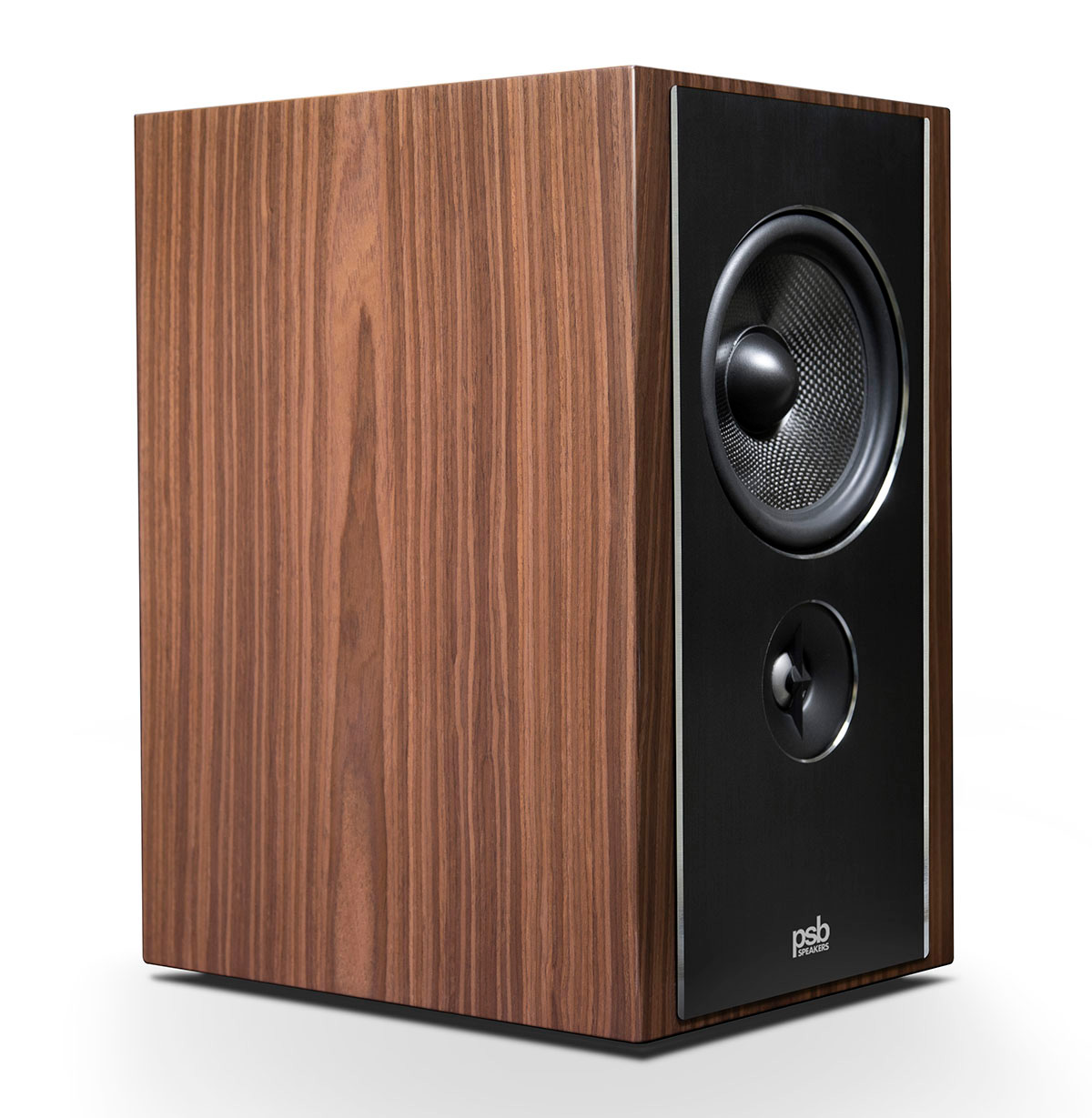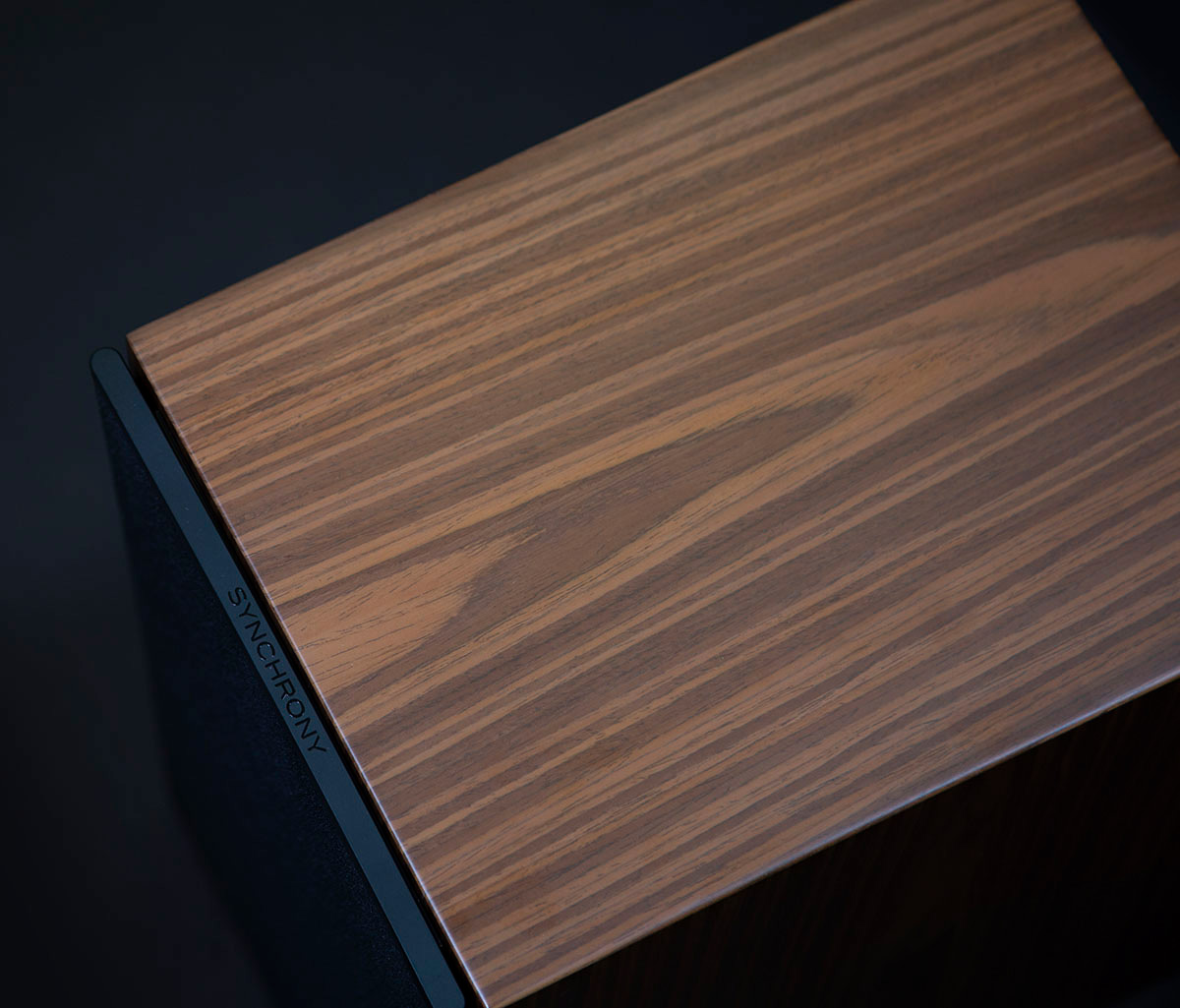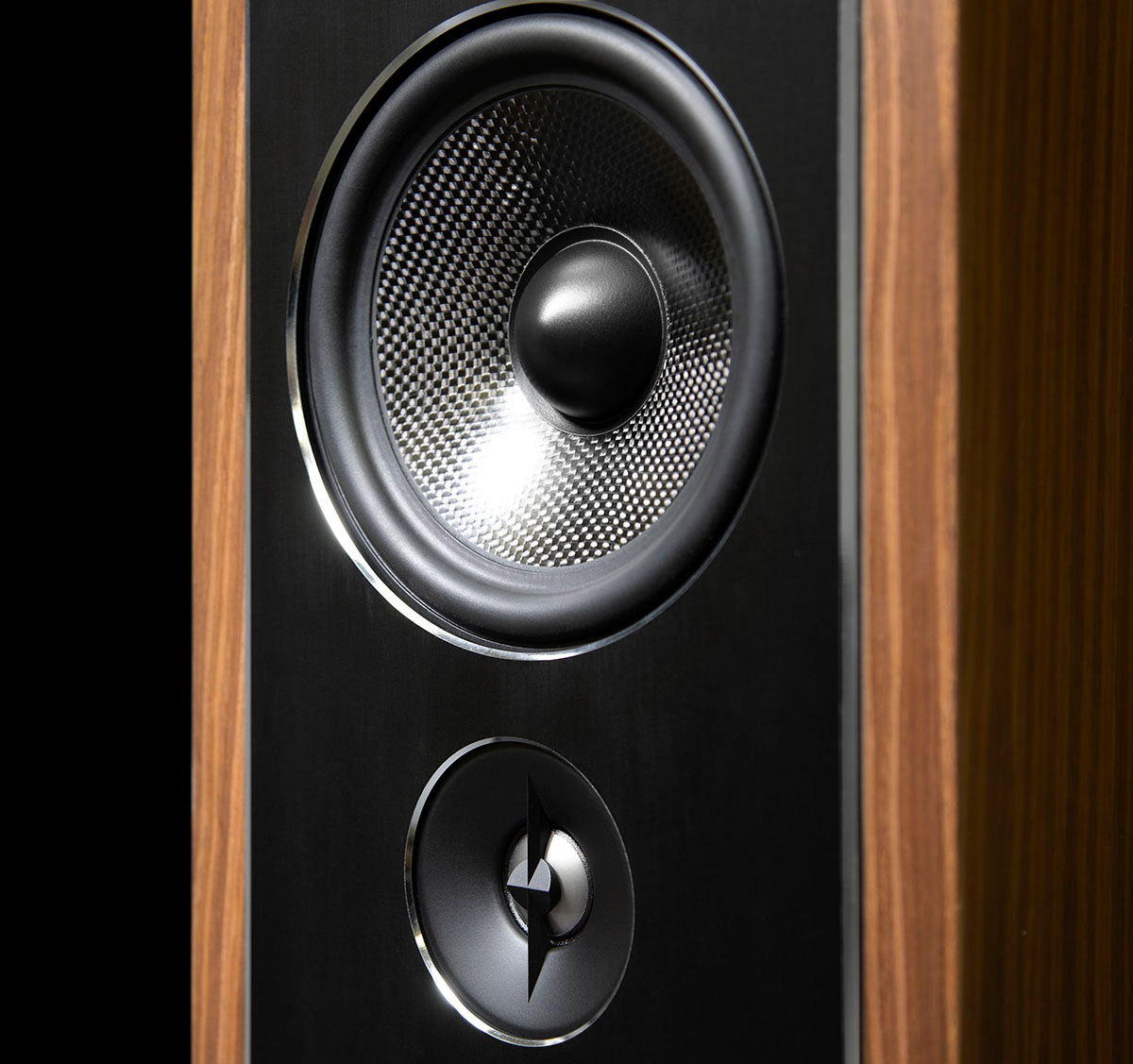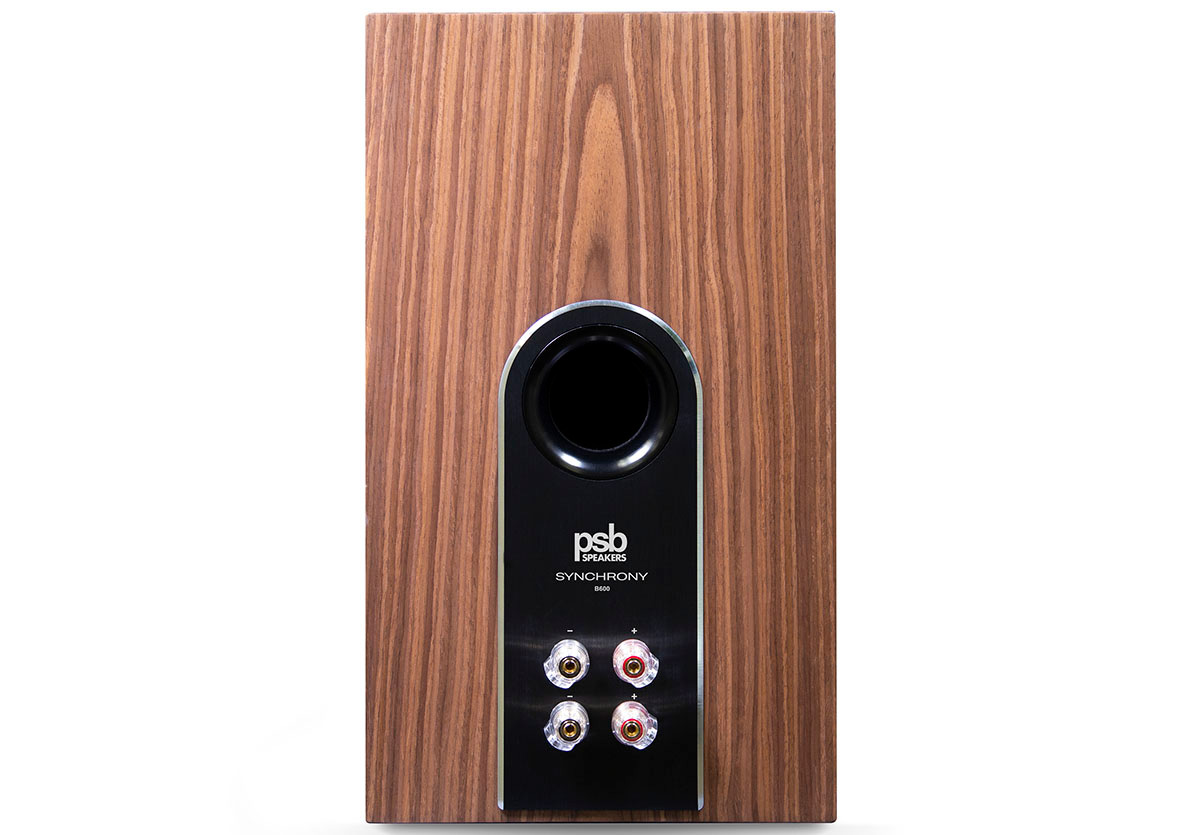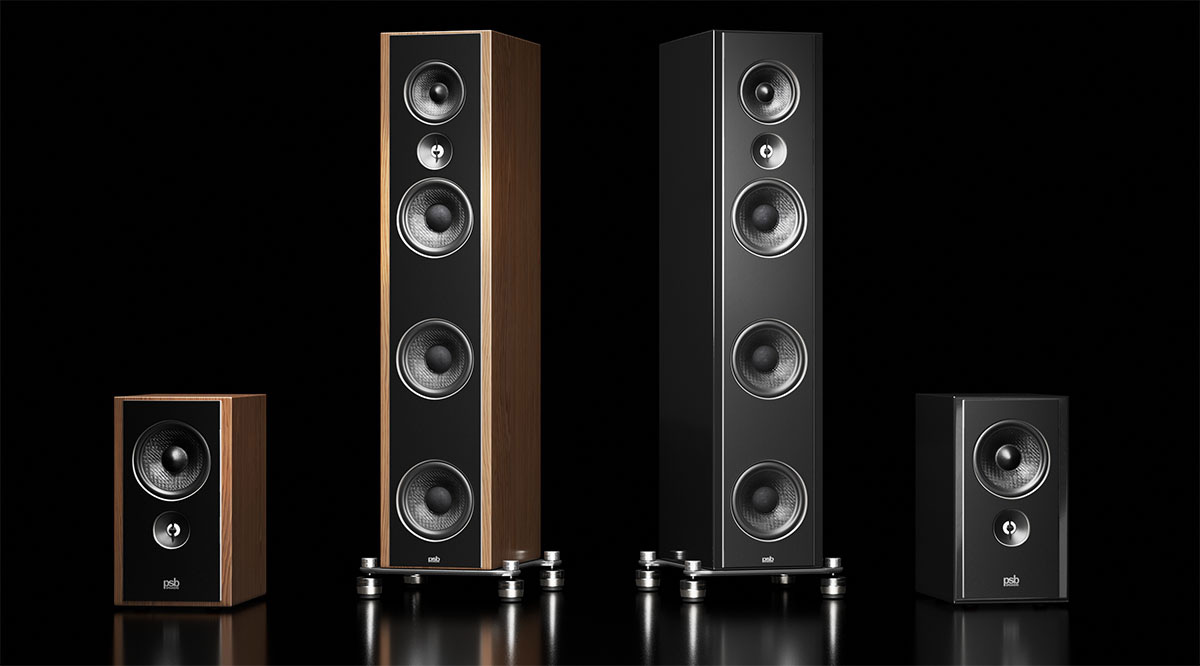Fans of Canadian speakers, myself included, will rejoice in PSB’s new line of Synchrony speakers. The B600 bookshelf model sports a simple and elegant look with all new drivers, a milled aluminum front baffle, special feet from ISO Acoustics, and a carefully engineered cabinet; that all combine to deliver premium sound, high performance, and excellent value. Designed by Paul Barton at Canada’s famed National Research Council labs, it represents the next evolution in a storied line of speakers.
PSB Synchrony B600 Bookshelf Speaker
- Two-way bass reflex bookshelf/stand-mount speaker.
- 1-inch titanium dome tweeter with ferrofluid cooling.
- 6.5-inch woven carbon fiber woofer with cast basket and rubber surround.
- Dual pairs of binding posts for bi-amp or bi-wire.
- ISO Acoustics isolator feet included.
- Milled aluminum front baffle.
Representing PSB’s flagship series, the Synchrony line of premium speakers has always delivered tremendous performance and value. For 2021, everything has been redesigned with new cabinets, front baffles, drivers, and isolator feet. Thanks to the resources available at Canada’s National Research Council (NRC) labs and Paul Barton’s vast experience and knowledge that dates to the founding of PSB speakers in 1972, the B600 Bookshelf Speaker delivers on the premise that has driven the company for almost 50 years.
Design Type:
2-way bass reflex, rear facing port
Frequency Response:
50-23,000Hz (+3dB)
Sensitivity:
anechoic 86dB, in-room 88dB (1w/1m)
Impedance:
6 Ohms
Input Power:
15-150 Watts
Tweeter:
1” (25mm) Titanium Dome with Ferrofluid
Woofer:
6.5” (165mm) cast basket, woven carbon fiber cone, rubber surround
Crossover:
2,200Hz, L4
Dimensions (WxHxD):
9” x 15.5” x 11.5”
Weight:
23lbs
PSB Synchrony B600 Bookshelf Speaker Price:
$2,499/pair
Website:
Company:
SECRETS Tags:
Speaker Review 2021, PSB, Synchrony, B600, bookshelf speaker, speaker review
- Klipsch The Fives Review
- PSB Alpha AM5 Powered Loudspeaker Review
- Sonus Faber Electa Amator III Speaker Review
The B600 Bookshelf speaker sticks to PSB’s well-established simple and elegant design language. The cabinet is a basic rectangular box with smoothly rounded edges. My samples were finished in satin walnut veneer which is a nice alternative to the high-gloss surfaces found on most speakers. It does not reflect light which is a good thing when placing them near a television or projection screen. They also resist fingerprints which will be great for households with small children.
Inside, the cabinet is heavily braced to be as inert as possible. The internal wiring is wrapped in a soft fabric to prevent any audible vibration. Of course, it passed the rap test when I knocked on it with my fist. But the real test is how much the sides of the box vibrate when the speaker’s playing. I cranked up some bass-heavy music and held an open palm on the sides. I could feel only the faintest vibration as if the speaker were on the other side of a wall. Impressive!
The front baffle is a milled plate made from black anodized aluminum. The finish is brushed very subtly, just enough to cut light reflection. The edges and driver cutouts are milled and polished to reveal the natural metal color underneath creating a silver accent. The look is very contemporary and should appeal equally to audio techies and significant others. If you’d rather cover the front, a magnetically attached grill is included which by my observation, did not affect the sound in any way. I enjoyed looking at the driver array, so I left them off.
The drivers are brand-new, designed, and engineered from the ground up. The tweeter is a one-inch titanium dome supported and cooled by ferrofluid. It sits inside a large waveguide that’s nearly 2.75 inches across. Set vertically across the dome is a specially shaped acoustic lens. All this engineering serves to improve dispersion and off-axis response.
The woofer is a 6.5-inch woven carbon fiber dome with a fiberglass dust cap in the center. It’s supported by a high-excursion rubber surround that provides plenty of bass. It’s tightly controlled by the extremely stiff and light cone. Woven carbon fiber is one of the strongest and lightest materials from which to make driver cones. You can be sure that distortion will be nearly non-existent. Supporting the woofer is a rear-facing bass reflex port that extends the B600 down to 55Hz.
You’ll notice in the photo that driver placement is unusual. Typical speakers, of all sizes, place the tweeter at the top or at least in the upper half of the baffle. Paul Barton has flipped this arrangement, putting the tweeter under the woofer. This arrangement focuses the in-phase lobe at the crossover frequency when using a Fourth Order Linkwitz-Riley acoustic crossover filter. It aligns phase at the crossover frequency to where the listener’s ears are in the room, which means the sound is the same whether you’re sitting or standing. The T600 towers have the midrange driver above the tweeter, achieving the same benefits.
Around back, you’ll find another milled aluminum plate around the port and the dual pairs of insulated five-way binding posts. You can bi-amp or bi-wire the B600s or leave the included jumpers in place to single-wire them. The posts can accommodate heavy bare wire, spades, or banana plugs.
The feet deserve special mention here. PSB has partnered with ISO Acoustics to install isolating feet on all the new Synchrony speakers. The B600 gets a low-profile rubber model that completely isolates the cabinet from whatever surface it’s placed on.
Though termed a bookshelf speaker, the Synchrony B600 is not small enough to fit on the average bookshelf. At nearly 12 inches deep, you’ll need an awfully large wall unit to accommodate it. And pushing it up against a back wall would block the rear-facing bass port. For my purposes, I’m treating it as a stand-mount speaker. It needs some breathing room for the best possible sound and performance.
Thankfully, PSB makes stands available and they were kind enough to provide me a pair. They bolt together easily with included tools and once assembled, are monolithic. Their feet have integrated spikes and floor-protector discs are included if you don’t have carpet. I do so the feet stayed in the box. The spikes can be adjusted with an Allen wrench, then locked down with large knurled nuts. The stands sell for an additional $599.
I went for a typical placement where I multiply the speakers’ distance from each other by 1.5 to set the listening position. I toed them in slightly, so they converged about 18 inches behind my head. This created a sound stage much wider than the speakers; in fact, it extended beyond the walls of my room.
I connected the B600s using Blue Jeans 10AWG speaker cable with heavy-duty locking banana plugs, single-wired with jumpers installed. Electronics were an Anthem AVM-70 processor and Emotiva XPA-5 power amplifier run through a Clarus Duet Power Block. Listening was done purely in two-channel mode with no processing, no room correction, and no subwoofer. Music was streamed via AirPlay from an iPhone 12 directly to the AVM-70. All tracks were CDs ripped to Apple Lossless.
If you are a fan of Canadian loudspeakers or own some yourself as I do, you won’t be surprised by the sound and performance of the Synchrony B600s, but you will be impressed. The real star here is their size. Lots of small speakers deliver big sound these days but PSB has clearly advanced the state of the art. Not only do they deliver far more and better bass than a small box should, but their dispersion characteristics are also superb. I walked around the room during all listening sessions and was amazed at how little the sound changed. There was no clear falloff of any frequency band. The soundstage shifted a little but that was hard to discern. The B600s are great to either plant yourself in front of, or to entertain a group of friends.
I spent the first day listening to only classical music – full orchestra, chamber music, and some solo piano. The B600s are first and foremost, neutral in sound. They will not color the original material in any way. Their job is to fill the room with sound and reproduce recordings faithfully. This they do with ease. Regardless of the quality of your media, they will fill the room with a spacious sound stage that goes beyond the speakers and in my case, beyond the confines of the space.
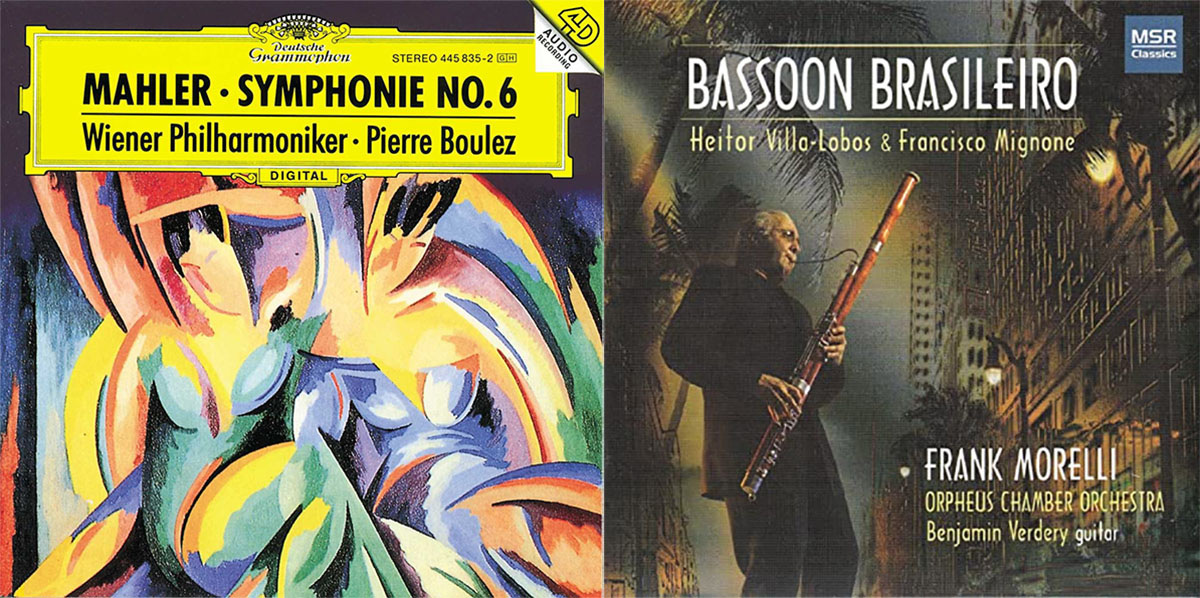
I started with Mahler’s Sixth Symphony, known by various names such as Tragic, Military, and my favorite, The Hammer, a reference to the hammer blows called for in the fourth movement. It’s scored for a massive orchestra of over 100 musicians and my recording with the Vienna Philharmonic and Pierre Boulez is appropriately bombastic. The B600s immediately showed their bass prowess with tight control and lots of energy down to the lowest notes of the tuba and contrabassoon. Tympani strikes and the hammer blows had plenty of impact. Massed strings had a nice tactility despite the large numbers of players. Brass fanfares rang through with strong highlights. Woodwind lines carried the middle dynamics down to the softest pianissimo.
Moving on to the opposite end of the spectrum, I listened to bassoonist Frank Morelli’s performance of 16 Waltzes for Bassoon Solo by Francisco Mignone. These pieces are perfectly written for the instrument and represent an iconic work not only for the bassoon but for this lesser-known Brazilian composer. Morelli’s interpretations are appropriate for the music and very enjoyable to anyone, not just bassoonists. The B600s had no trouble reproducing his sound very realistically. I’ve heard him play live and found the PSBs to be very accurate. Even the subtle clicking of his keywork was evident, further creating the sense of a live performance. The sense of space was clear too with a wet sound that expanded the sound stage beyond the boundaries of my room.

I experienced the same feel when listening to Valeri Popov and his protégé play Sophia Gubaidulina’s Duo Sonata for Two Bassoons. They obviously recorded the work in a resonant recital hall, and I felt as though I were sitting in the fifth row center. I’ve also found the live experience when listening to my new go-to album of solo piano music, Masters of the Piano: Chopin, performed by Idil Biret. The piano is obviously close-mic’ed here which lends a nice percussiveness to the tone. Hearing the hammers hit the strings adds a nice texture which Biret controls perfectly. The B600s made it easy to hear her every nuance and inflection.
Can the Synchrony B600s rock? That’s a definite yes, with an exclamation point! I tried several different styles as well as recordings of varying quality and in every case, the nuances of guitar distortion, bass control, vocal textures, and overall balance were laid bare.

Metallica is a group well known for albums that run the gamut from high fidelity to compressed mush. While their signature thrash style is always clear, you can explore the classic 80s mix in something like Master of Puppets, or you can go for a better-crafted product like Hardwired…to Self-Destruct from 2016. In both cases, Metallica’s unique guitar sound was easy to discern. The funny thing about distorted guitars is even though audiophiles consider distortion something to be avoided, it can take on many unique forms. Making this distinction is something only the best speakers can manage. The B600s handle this challenge with ease. I could easily hear the 30-year evolution of Kirk Hammett’s sound. The newer version is far richer in its partials and more tactile during chord changes. Solos came across detailed and clear. The spaces between notes provided a great contrast as well. The B600s made sure I heard exactly what Metallica and their sound engineers intended.
Also from the 80s was my copy of Styx’s Pieces of Eight. None of this group’s recordings stands out as an audiophile tour de force but they are all competently and consistently mixed. Volume compression was apparent but did not distract. The drum track came across nicely with a solid thump that the B600s woofer controlled perfectly. The sparkle of James Young’s Stratocaster and Dennis DeYoung’s classic synthesizer tones created an ideal layer of sound that never became harsh or strident.
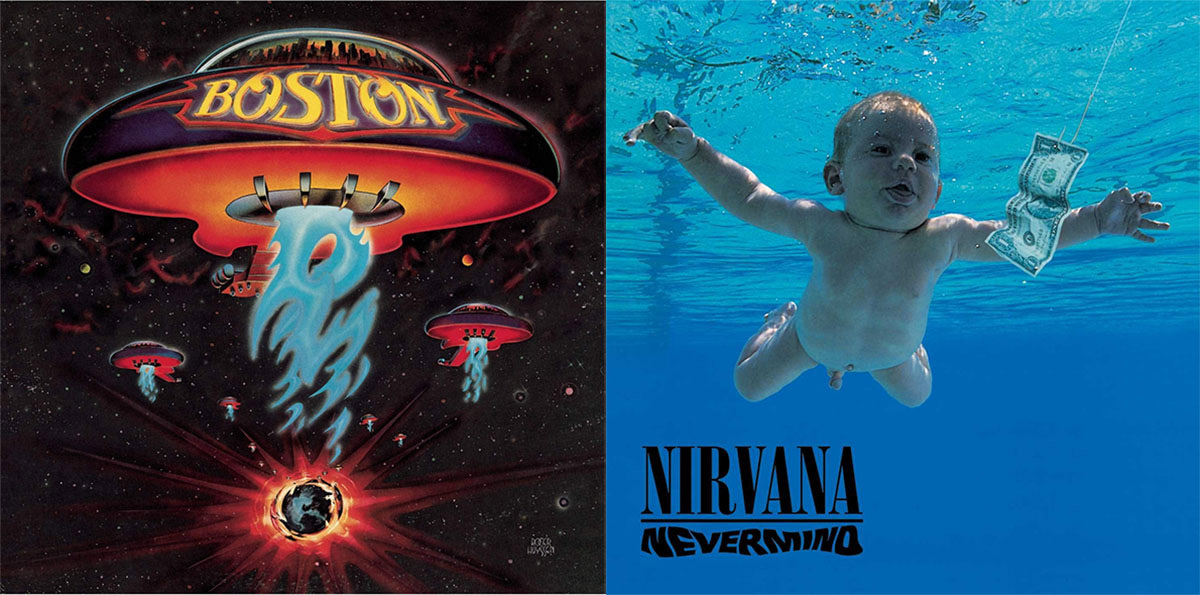
To explore a completely different sound from the 80s, I went for Boston’s debut album, Boston. This is one of the most meticulously engineered recordings of any genre. Tom Scholz spent thousands of hours in his basement creating what became one of the best-selling rock albums of all time. Hearing it next to other groups from the era shows a clear difference in fidelity. The B600s demonstrated this from the get-go. Not only is there far more depth and contrast, the different instrument sounds each occupies their own space in the room. It’s amazing to hear two small boxes create an arena-like feel in a relatively small room. With lead guitar in the left channel, drums and vocal in the phantom center space, and bass in the right, I had everything from a live performance except the teeming throngs of sweaty screaming fans.
If you’re looking to capture the club feel, look no further than Nirvana’s Nevermind. This is a masterfully mixed record from Butch Vig and harkens back to the underground scene in Seattle that birthed grunge and the pop styles that followed. The B600s displayed Kurt Cobain’s array of different guitar pedals and his voice which has just enough gravel to give it character. Drums and bass also came through with just the right weight.
The PSB Synchrony B600 Bookshelf Speakers deliver premium sound and build quality at a very competitive price thanks to a legacy of thoughtful engineering.
- Impressive bass control and output.
- Wide dispersion with excellent off-axis sound quality.
- Unfailingly neutral.
- Premium finish and build quality.
- No flaws of consequence.
It is thanks to the experience of designers like Paul Barton that we have speakers like the PSB Synchrony B600. When the laws of physics attempt to force us into creating ever-larger cabinets with lots of drivers just to get a big sound and deep bass, there are engineers that say, “this doesn’t have to be.” The B600s are the embodiment of that philosophy.
From their small footprint, they produce a huge sound stage that easily hides their placement. My room was transformed into many different spaces during the review – arena, nightclub, recital hall, symphony stage; every venue was clearly presented. And the B600s never strayed from their neutrality. Poorly recorded music will sound poorly recorded. But masterfully created albums will shine at their full potential.
Whether your interests lie in classical or rock, or if you’re a fan of everything, the PSB Synchrony B600 Bookshelf Speakers are a great choice for those needing something small and unobtrusive. They play far beyond their physical presence and will transform your room into a different space. Highly Recommended.





